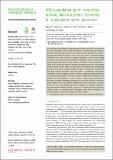Files in this item
Within-population sperm competition intensity does not predict asymmetry in conpopulation sperm precedence
Item metadata
| dc.contributor.author | Garlovsky, Martin D. | |
| dc.contributor.author | Yusuf, Leeban H. | |
| dc.contributor.author | Ritchie, Michael G. | |
| dc.contributor.author | Snook, Rhonda R. | |
| dc.date.accessioned | 2020-10-30T12:30:13Z | |
| dc.date.available | 2020-10-30T12:30:13Z | |
| dc.date.issued | 2020-12-07 | |
| dc.identifier | 270956269 | |
| dc.identifier | 5cc38d3e-3fe3-4dda-98d2-11f8ec9bc584 | |
| dc.identifier | 85091687197 | |
| dc.identifier | 33070721 | |
| dc.identifier | 000585265500010 | |
| dc.identifier.citation | Garlovsky , M D , Yusuf , L H , Ritchie , M G & Snook , R R 2020 , ' Within-population sperm competition intensity does not predict asymmetry in conpopulation sperm precedence ' , Philosophical Transactions of the Royal Society. B, Biological Sciences , vol. 375 , no. 1813 , 20200071 . https://doi.org/10.1098/rstb.2020.0071 | en |
| dc.identifier.issn | 0962-8436 | |
| dc.identifier.other | ORCID: /0000-0001-7913-8675/work/82788582 | |
| dc.identifier.uri | https://hdl.handle.net/10023/20862 | |
| dc.description | Funding: M.D.G. was supported by an Adapting to the Challenges of a Changing Environment (ACCE) Doctoral Training Partnership grant no. NE/L002450/1, funded by the Natural Environment Research Council (NERC). L.H.Y. was supported by a studentship funded bythe University of St Andrews and MGR. | en |
| dc.description.abstract | Postcopulatory sexual selection can generate evolutionary arms races between the sexes resulting in the rapid coevolution of reproductive phenotypes. As traits affecting fertilization success diverge between populations, postmating prezygotic (PMPZ) barriers to gene flow may evolve. Conspecific sperm precedence is a form of PMPZ isolation thought to evolve early during speciation yet has mostly been studied between species. Here, we show conpopulation sperm precedence (CpSP) between Drosophila montana populations. Using Pool-seq genomic data we estimate divergence times and ask whether PMPZ isolation evolved in the face of gene flow. We find models incorporating gene flow fit the data best indicating populations experienced considerable gene flow during divergence. We find CpSP is asymmetric and mirrors asymmetry in non-competitive PMPZ isolation, suggesting these phenomena have a shared mechanism. However, we show asymmetry is unrelated to the strength of postcopulatory sexual selection acting within populations. We tested whether overlapping foreign and coevolved ejaculates within the female reproductive tract altered fertilization success but found no effect. Our results show that neither time since divergence nor sperm competitiveness predicts the strength of PMPZ isolation. We suggest that instead cryptic female choice or mutation-order divergence may drive divergence of postcopulatory phenotypes resulting in PMPZ isolation. This article is part of the theme issue 'Fifty years of sperm competition'. | |
| dc.format.extent | 9 | |
| dc.format.extent | 2725538 | |
| dc.language.iso | eng | |
| dc.relation.ispartof | Philosophical Transactions of the Royal Society. B, Biological Sciences | en |
| dc.subject | Conspecific sperm precedence | en |
| dc.subject | Demographic history | en |
| dc.subject | Postcopulatory sexual selection | en |
| dc.subject | Postmating prezygotic reproductive isolation | en |
| dc.subject | Speciation | en |
| dc.subject | Sperm competition | en |
| dc.subject | QH301 Biology | en |
| dc.subject | QH426 Genetics | en |
| dc.subject | Agricultural and Biological Sciences(all) | en |
| dc.subject | Biochemistry, Genetics and Molecular Biology(all) | en |
| dc.subject | DAS | en |
| dc.subject.lcc | QH301 | en |
| dc.subject.lcc | QH426 | en |
| dc.title | Within-population sperm competition intensity does not predict asymmetry in conpopulation sperm precedence | en |
| dc.type | Journal article | en |
| dc.contributor.institution | University of St Andrews. Centre for Biological Diversity | en |
| dc.contributor.institution | University of St Andrews. School of Biology | en |
| dc.contributor.institution | University of St Andrews. Institute of Behavioural and Neural Sciences | en |
| dc.identifier.doi | 10.1098/rstb.2020.0071 | |
| dc.description.status | Peer reviewed | en |
This item appears in the following Collection(s)
Items in the St Andrews Research Repository are protected by copyright, with all rights reserved, unless otherwise indicated.

